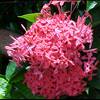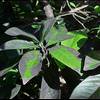This plant may be available to buy
Click the banana to see

|
click pic to enlarge |
|
Zone 10 Ixora may be the most common flowering shrub seen in South Florida and 'Nora Grant' likely the most popular of them all. Related to the gardenia and coffee plants, Ixora is said to be native to Asia and whose name derives from an Indian deity There are about 400 species spread from Africa to India to Southern Asia. For red color, ixora is popular in warm South Florida with blooms all year long, but maximum beauty is from late spring through the early winter months, peaking in the hot months To see specimen-quality bloom performance, click here The many types used in South Florida vary with leaf size, plant height, flower size and flower color. Cut flower stems are long lasting brought indoors. Here's a nice orange ixora Often ixora 'Nora Grant' is used as a hedge, but this is inappropriate. The leaves are too large to be a good hedge material and typical hedge pruning cuts off most of the stem tips from which flowers emerge. Best is to use Ixora coccinea for hedges Not all ixoras are grown for flower color. For example, Ixora odorata from Madagascar (hard to find in South Florida) requires tropical shade, produces huge 10-inch blooms on a 4-5 foot bush whose attraction is also a wonderful lingering scent. Excellent for shaded front door porches or backyard sitting areas Almost all ixoras do best in full sun, acid soil, free from nematodes, a moist organic mix that is also well drained. Ixora can endure some salt spray on the wind. Planted in shady areas or with excess water on leaves, sooty mold usually sets in click pic to enlarge A common problem is alkaline soils in Florida, especially near concrete and pools, causing poor health, poor foliage and poor blooming. This is especially true for yellow and dwarf ixora varieties. For best results, mix Canadian peat moss as a soil amendment and always use acid forming fertilizer. Minor trace elements are important as well Older ixora plants may be attacked by root-knot nematodes ...tiny worm-like creatures which bore into roots and weaken the plant. If you have an old ixora hedge and one or two plants decline, you may pull them out and look at the roots to see if this appearance is present Named Ixora varieties locally available include:
Exotic Ixoras rare and hard to find include:
|

